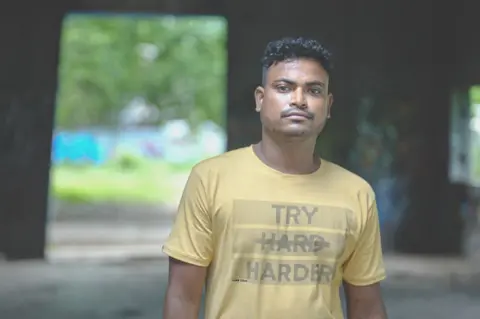 Ronnie Sen for the BBC
Ronnie Sen for the BBCOver the past three decades, at least 565 children in the Indian state of West Bengal have been injured or killed by homemade bombs, according to a BBCI investigation.
So what are these deadly devices and how are they linked to political violence in West Bengal? Why do so many Bengali children pay the price?
On a bright summer morning in May 1996, six boys from a slum in Kolkata, the capital of the Indian state of West Bengal, went out to play cricket in a narrow alley.
The shantytown they lived in, located in the middle-class neighborhood of Jodhpur Park, was bustling with life. It was a holiday – voting day in the general election.
One of the boys, nine-year-old Bochu Sardar, grabbed a cricket bat and quietly slid in front of his sleeping father. Soon the noise of the bat ball flying echoed through the alley.
A ball came out of the confines of their makeshift playground, prompting the boys to search for it in a small nearby park. There, in a black plastic bag, they found six round objects.
They looked like cricket balls that someone had left behind, and the boys returned to the game with their spoils.
One of the “balls” was thrown from the bag at Puchu who hit it with his bat.
A deafening explosion tore through the alley. It was a bomb.
As the smoke rose and the neighbors rushed outside, they found Bucho and five of his friends lying in the street, their skin blackened, their clothes burned, and their bodies torn apart.
Screams pierced the chaos.
Seven-year-old Raju Das, an orphan raised by his aunt, and seven-year-old Gopal Biswas died of their injuries. Four other boys were injured.
Bucho narrowly escaped, after suffering serious burns and shrapnel wounds to his chest, face and abdomen.
He spent more than a month in the hospital. When he returned home, he had to use kitchen tongs to remove the splinters that were still stuck in his body because his family no longer had money to pay for any further medical care.
Bochu and his friends are part of a long and tragic list of children killed or maimed by crude bombs, which have been used in West Bengal for decades in a bloody battle for control of the state’s violent politics.
There are no publicly available figures on the number of casualties in West Bengal.
So the BBC World Service reviewed every issue of two prominent government newspapers – Anandabazar Patrika and Parthaman Patrika – from 1996 to 2024, looking for reports of children being injured or killed by these devices.
We found at least 565 child victims – 94 deaths and 471 injuries – as of 10 November. This means that a child falls victim to bomb violence, on average, every 18 days.
However, the BBC found incidents in which children were injured by these bombs that were not reported by the two newspapers, so the real number of victims is likely higher.
More than 60% of these incidents involved children playing outdoors – in parks, streets, farms, and even near schools – where bombs, commonly used during elections to terrorize opponents, were hidden.
Most of the victims the BBC spoke to were poor people, children of domestic workers, sole proprietors, or farm workers.
The Revolutionary History of the Bombs in West Bengal
West Bengal, India’s fourth largest state with a population of more than 100 million, has long been plagued by political violence.
Over the years, since India’s independence in 1947, the country has oscillated between different rulers – the Congress for two decades, the communist-led Left Front for three years, and the current Trinamool Congress since 2011.
In the late 1960s, the country was rocked by armed conflict between Maoist rebels – also called Naxalites – and government forces.
A common thread across all governments and rebel conflicts since then has been the use of bombs as tools of intimidation by political parties to silence opponents, especially during elections.
“It was bombs [used to settle scores]. This has been happening in Bengal for a long time, more than 100 years, said Pankaj Dutta, former Inspector General of Police in West Bengal.
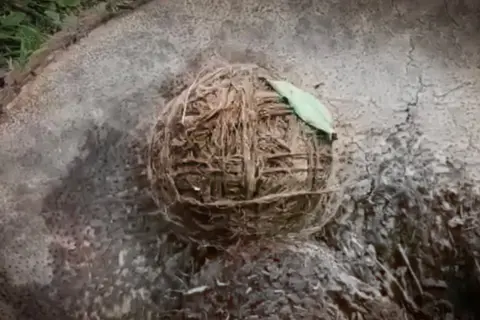 Ronnie Sen for the BBC
Ronnie Sen for the BBCThe roots of bomb making in Bengal go back to the rebellion against British rule in the early 20th century.
Early efforts were rudimentary and accidents were common: one rebel lost a hand and another died while testing a bomb.
Then one of the rebels returned from France armed with bomb-making skills.
His book bomb—a legal binder filled with explosives hidden in a Cadbury cocoa tin—would have killed its target, a British judge, had he opened it.
The first explosion rocked the Midnapore district in 1907, when revolutionaries derailed a train carrying a senior British official by planting a bomb on the tracks.
A few months later, a failed attempt to kill a judge in Muzaffarpur with a bomb thrown at a horse-drawn carriage killed two English women.
This act, which one newspaper described as “a massive explosion that stunned the city,” turned a teenage rebel named Khudiram Bose into a martyr and the first “freedom fighter” in the pantheon of Indian revolutionaries.
Bal Gangadhar Tilak, the nationalist leader, wrote in 1908 that bombs were not just weapons, but a new kind of “magical belief,” “witchcraft” spreading from Bengal to the rest of India.
Today, raw Bengal bombs are known locally as Bittu. It is tied with jute string and stuffed with splinter-like nails, walnuts and glass.
Variations include explosives packed in steel containers or glass bottles. They are used primarily in violent clashes between rival political parties.
Political activists, especially in rural areas, use these bombs to intimidate opponents, disrupt polling stations, or retaliate against perceived enemies.
They are often deployed during elections to sabotage polling stations or to assert control of areas.
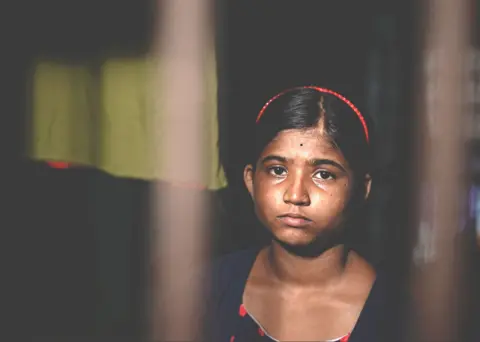 Ronnie Sen for the BBC
Ronnie Sen for the BBCChildren like Poulami Halder bear the brunt of this violence.
One April morning in 2018, the seven-year-old was picking flowers for morning prayers in Gopalpur, a village in North 24 Parganas district filled with ponds, rice fields and coconut trees. There is only one month left until the village council elections.
Boulami saw a ball lying near a neighbour’s water pump.
“I picked it up and brought it home,” she recalls.
When she went inside, her grandfather, sipping tea, froze at the sight of the object in her hand.
“He said, ‘It’s not a ball, it’s a bomb! Throw it away!’ Before I could react, it exploded in my hand.”
The explosion shattered the tranquility of the village. Boulami was hit in her “eyes, face and hands” and fainted as chaos erupted around her.
“I remember people running towards me, but I could see little. I was hit everywhere.”
The villagers took her to the hospital.
Her injuries were devastating, as her left hand was amputated and she spent nearly a month in hospital.
An ordinary morning routine had turned into a nightmare, changing Polami’s life forever in one shattering moment.
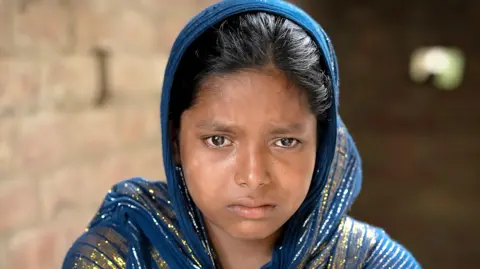 Ronnie Sen for the BBC
Ronnie Sen for the BBCBoulami is not alone.
Sabina Khatun was 10 years old when a makeshift bomb exploded in her hand in April 2020 in Jeetpur, a village surrounded by rice and jute fields in Murshidabad district.
She was taking her goat to graze when she found the bomb lying in the grass. Curious, she picked it up and started playing with it.
Moments later, the bomb exploded in her hands.
Her mother, Amina Bibi, said in a voice heavy with pain: “The moment I heard the explosion, I thought: Who will be disabled this time? Was Sabina mutilated?”
“When I came out, I saw people carrying Sabina in their arms. Flesh was visible from her hand.”
Doctors had to amputate Sabina’s hand.
Since returning home, she has struggled to rebuild her life, as her parents were mired in despair over an uncertain future. Their fears are not unjustified: in India, women with disabilities often face social stigma that complicates their chances of marriage and work.
“My daughter kept crying, saying she would never get her hand back,” Amina says.
“I kept comforting her and telling her, ‘Your hand will grow back, your fingers will grow back.’
Now, Sabina suffers from the loss of her hand and has difficulty performing simple daily tasks. “I have difficulty drinking water, eating, bathing, getting dressed, and going to the toilet.”

Sons of bombs
In the Indian state of West Bengal, children are routinely maimed, blinded or killed by homemade bombs. BBC Eye investigates the political violence behind this tragedy and asks why the massacre was allowed to continue.
Watch on iPlayer Or, if you are outside the UK, Watch on YouTube
These children, disfigured by the bombs but lucky to survive, have their lives changed forever.
Boulami, now 13, received a prosthetic hand but has been unable to use it because it is too heavy and quickly grows old. Sabina, 14, suffers from poor eyesight.
Her family says she needs another surgery to remove bomb debris from her eyes, but they cannot afford it.
Bucho, now 37, was taken out of school by his frightened parents and spent years refusing to come out, often hiding under his bed at the slightest noise.
He never picked up a cricket bat again. His childhood was stolen, and now he works odd construction jobs and carries the scars of his past.
But all hope is not lost.
Both Boulami and Sabina have learned to ride a bike with one hand and still go to school. They both dream of becoming teachers. Bochu hopes for a brighter future for his five-year-old son, Rudra, who wears the uniform of a policeman.
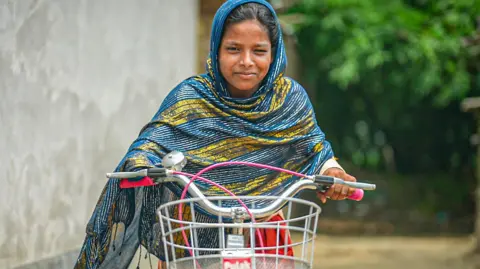 Ronnie Sen for the BBC
Ronnie Sen for the BBCDespite the heavy toll it causes, there is no sign of the bomb violence in West Bengal ending.
None of the political parties admits to using bombs for political gain.
When the BBC asked the four major political parties in West Bengal whether they were involved, directly or through intermediaries, in the manufacture or use of crude bombs, the ruling Trinamool Congress (TMC) and the opposition Bharatiya Janata Party (BJP) did not respond.
The Communist Party of India (Marxist) has strongly denied its involvement, saying it is “committed to upholding the rule of law… and that when it comes to protecting rights and lives, children are of utmost concern.”
The Indian National Congress also strongly denied using improvised bombs for electoral gain, and said it had “never engaged in any acts of violence for political or personal gain.”
Although no political party has admitted responsibility, experts who spoke to the BBC do not doubt that this massacre is rooted in the culture of political violence in Bengal.
“During any major election here, you will see rampant use of bombs,” Pankaj Dutta told us. “Severe childhood abuse continues. It’s a lack of care on the part of society.” Mr. Dutta died in November.
“Those who planted the bombs are still free,” Boulami adds. “No one should leave bombs lying around. No child should ever be harmed in this way again.”
“Look what they did to my son”
But the tragedy continues.
In May this year, in Hooghly district, three boys playing near a pond found a bomb cache. The explosion killed nine-year-old Raj Biswas, and caused his friend to be disfigured and lose his arm. The other boy survived with a broken leg.
“Look what they did to my son,” Raj’s heartbroken father cried as he caressed his dead child’s forehead.
As Raj’s body was lowered into the grave, political slogans echoed in the air from a nearby election rally: “Hail Bengal!” The crowd chanted “Hail Bengal!”
It was election time. Once again, children were paying the price.
https://ichef.bbci.co.uk/news/1024/branded_news/ca20/live/ad768680-b96b-11ef-a2ca-e99d0c9a24e3.jpg

